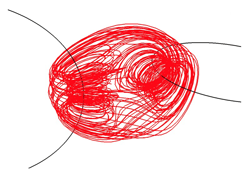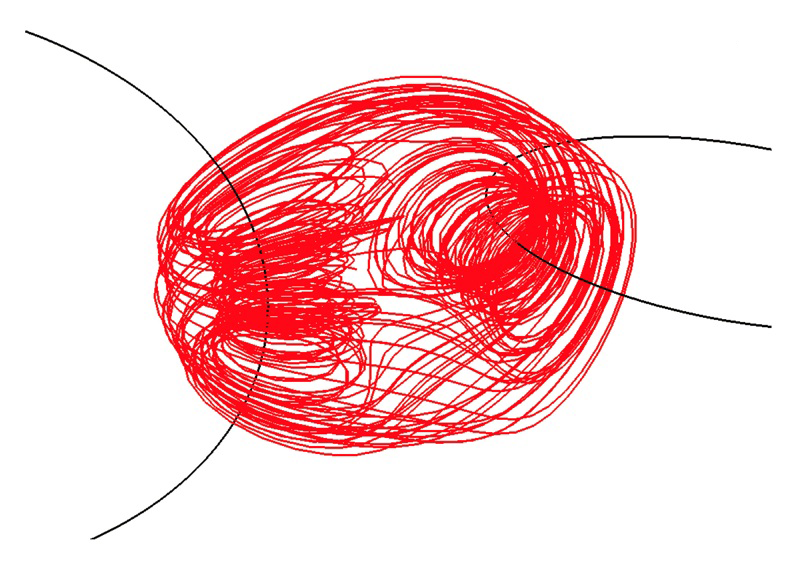Magnetic Fields in Chaos
The magnetic fields generated by electric currents in wires are typically depicted as neat closed loops, but this may be more the exception than the rule. Computer-based calculations in the December Physical Review E show that magnetic field lines around simple wire configurations are tangled up like a ball of yarn. After accounting for the earth’s magnetic field, the researchers conclude that these chaotic magnetic fields are ubiquitous in the circuits found in all modern electronic devices.
A magnetic field line can be thought of as the path taken by a hiker continuously walking where her compass needle points. Textbooks generally show magnetic field lines curling around current-carrying wires to form closed loops. However, in plasmas–where currents flow in complex arrangements–the magnetic field lines often don’t close but instead wrap around themselves in three-dimensional space an infinite number of times. These chaotic magnetic fields have been studied for decades by those working on fusion reactors, as well as those trying to understand the atmosphere of the sun.
The conventional wisdom has been that this chaos is confined to plasmas, but recent theoretical work has shown that chaotic magnetic fields also arise from the currents through special wire configurations, such as an undulating wire bent into a loop [1]. Now Makoto Hosoda of Osaka City University in Japan and his colleagues have looked at even simpler wire arrangements, some of which are representative of the wiring inside ordinary electronic devices.
The main example consisted of two adjacent circular loops tilted at 90 degrees to each other. The researchers’ computer program picked an arbitrary starting point near the loops and calculated the magnetic field using standard formulas for the sum of two single loops. It then moved incrementally in the field’s direction and continuously calculated the magnetic field at each point. With this technique, the team traced out the path of a single magnetic field line and showed the line weaving in and out of the two loops without ever retracing its steps. To confirm that this was chaos, the team showed that a slight change in starting point leads to a wildly different line trajectory, the classic definition of chaos.
Hosoda and his colleagues did similar tests on other wire combinations, adding in the earth’s magnetic field. For centimeter-wide loops carrying 10 amperes of current, they found that the earth’s uniform field overwhelms the current-induced field and washes away the chaos. The field lines are complex–forming small knots around the wires–but any field line that you follow eventually straightens out and extends away from system. However, when the team analyzed representative versions of the much smaller wire circuits that can be found in our televisions, computers, and cell phones, the magnetic fields were stronger, and the chaos resisted the geomagnetic field.
This robust chaos may be a good thing, says co-author Katsuhiro Nakamura of the Uzbek Academy of Sciences in Tashkent, Uzbekistan. “Non-chaotic” magnetic fields could in principle be strong enough to disrupt current flow at certain points. “By contrast, chaos smears out the macroscopic magnetic field and guarantees the stable operation of modern technological devices,” Nakamura says.
“This paper is an interesting numerical application of an already known concept to a realistic example and reinforces the fact that magnetic lines are generically complex in any practical case,” says Jacobo Aguirre of the Center for Astrobiology in Madrid. He believes it will be a real challenge to check these results experimentally. Undeterred, Hosoda is considering building a meter-scale mock-up of his team’s simulations. The presence of chaotic fields might be verified with magnetic sensors that can track individual field lines, or with an electron beam whose scattering pattern would depend on the details of the fields.
–Michael Schirber
Michael Schirber is a Corresponding Editor for Physics Magazine based in Lyon, France.
References
- J. Aguirre, and D. Peralta-Salas, “Realistic Examples of Chaotic Magnetic Fields Created by Wires,” Euro. Phys. Lett. 80, 60007 (2007)





